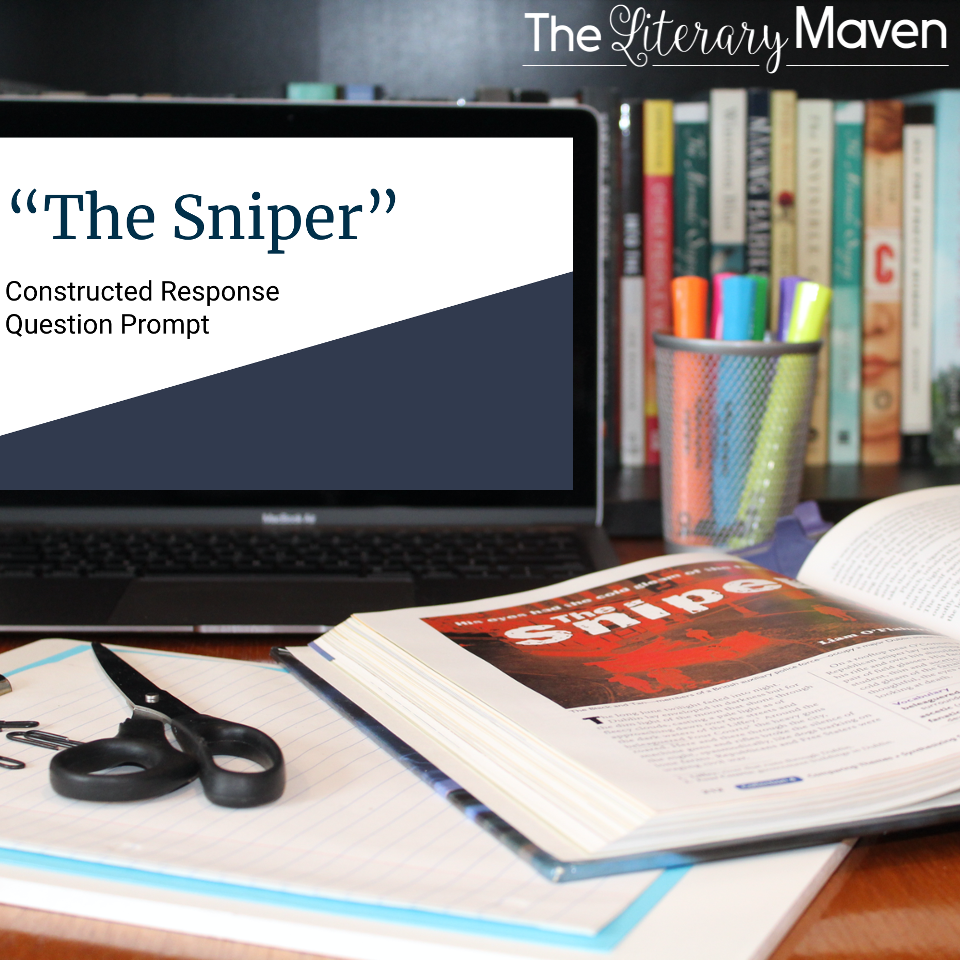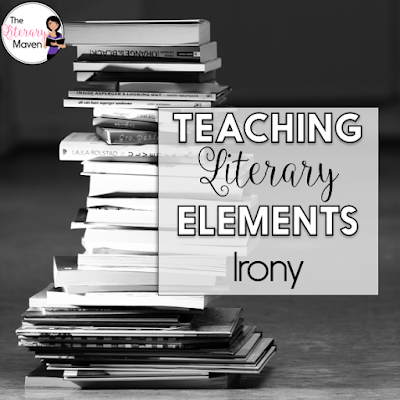Irony is one of my favorite literary elements to teach. Who doesn't love a good plot twist? I love challenging students to find their own examples of irony from songs, films, and books. Whether you are teaching the types of irony as new concepts for your students, diving in deeper, or just reviewing the basics, you'll find activities and resources below that will benefit all levels of students.
“The Interlopers” by Saki is another short story that is sure to hook reluctant readers. It is set at night and focuses on a long-standing turf war. The two main characters are out in the forest, the disputed territory, hunting each other, but as the two men meet, a tree falls and traps both of them beneath it. The twist at the end of the story makes it another great text to use for teaching irony.

Creative Application
Once students seem comfortable with the terms or if students need a challenge, I introduce students to a digital breakout, "Isn't It Ironic?" for additional practice. A digital breakout is an online scavenger hunt-like game where players use teamwork and critical thinking to solve a series of challenging puzzles in order to open a series of locks.
Terms to Teach
At the start of my teaching career, I taught primarily ninth grade students at an urban, Title 1 high school. My students came from a variety of K-8 schools, which meant they came with varying English Language Arts experiences. To ensure that all of my students started high school with a strong foundation in the literary elements, I found it best to give direct instruction followed by ample opportunities to apply terms and practice skills.
Before applying these newly learned terms to a short story or novel, I like to give my students opportunities to practice using shorter texts or media. For irony, using short video clips provides great visual reinforcement. I have collected examples of verbal irony, situational irony, and dramatic irony in this playlist. I play a few and have students identify the type of irony in the clip and explain what makes it ironic.
Another way I reinforce the types of irony is by using a menu of activities based on Bloom's Taxonomy. Students choose activities from four different section of the menu: knowledge and comprehension, application and analysis, synthesis, and evaluation. Students examine short text examples of different types of irony and can use their knowledge to complete tasks such as creating a cartoon illustrating one of the types of irony.
Texts to Read
There are so many great short stories that have irony in them. "The Sniper" by Liam O'Flaherty is one I often use because I’m always looking for texts that will draw in my reluctant male readers. Anything with war, guns, or a little violence ups the appealing factor immediately. “The Sniper” is set in the 1920s during the Irish revolution. A sniper is stationed on a rooftop contemplating how he will get down before the light of dawn exposes him. I often use this text when teaching irony because of its unexpected ending.

At the start of my teaching career, I taught primarily ninth grade students at an urban, Title 1 high school. My students came from a variety of K-8 schools, which meant they came with varying English Language Arts experiences. To ensure that all of my students started high school with a strong foundation in the literary elements, I found it best to give direct instruction followed by ample opportunities to apply terms and practice skills.
During my direct instruction, I introduced students to the following terms: irony, verbal irony, situational irony, and dramatic irony. While I wouldn't have students take notes on sarcasm and coincidence, I would review how those are different from verbal irony and situational irony. Many of my students were unaccustomed to taking notes so I provided them with a guided note taking template. This three column sheet provided a structured space for the term, definition, and examples. This note taking PowerPoint has clear, concise definitions and examples plus built in guided and independent practice.
Activities for ReinforcementBefore applying these newly learned terms to a short story or novel, I like to give my students opportunities to practice using shorter texts or media. For irony, using short video clips provides great visual reinforcement. I have collected examples of verbal irony, situational irony, and dramatic irony in this playlist. I play a few and have students identify the type of irony in the clip and explain what makes it ironic.
Another way I reinforce the types of irony is by using a menu of activities based on Bloom's Taxonomy. Students choose activities from four different section of the menu: knowledge and comprehension, application and analysis, synthesis, and evaluation. Students examine short text examples of different types of irony and can use their knowledge to complete tasks such as creating a cartoon illustrating one of the types of irony.
Texts to Read
There are so many great short stories that have irony in them. "The Sniper" by Liam O'Flaherty is one I often use because I’m always looking for texts that will draw in my reluctant male readers. Anything with war, guns, or a little violence ups the appealing factor immediately. “The Sniper” is set in the 1920s during the Irish revolution. A sniper is stationed on a rooftop contemplating how he will get down before the light of dawn exposes him. I often use this text when teaching irony because of its unexpected ending.

“The Interlopers” by Saki is another short story that is sure to hook reluctant readers. It is set at night and focuses on a long-standing turf war. The two main characters are out in the forest, the disputed territory, hunting each other, but as the two men meet, a tree falls and traps both of them beneath it. The twist at the end of the story makes it another great text to use for teaching irony.

I often teach irony right before the holidays, which makes "The Gift of the Magi" by O. Henry another excellent short story to use because of its message about giving and thinking of others. The story is set on Christmas Eve as a young, newly married couple, Jim and Della, struggles to find gifts that are worthy of each other. Both end up giving up what they treasure most to buy a gift for their loved one, but the twist at the end of the story makes their gifts worthless. The Onion recently published this satirical piece that would be a great pairing with the short story.
Fictional short stories are great, but I like to use nonfiction when teaching irony as well. No matter how much time has passed since its sinking, the Titanic continues to be a topic that fascinates students. "RMS Titanic" by Hanson Baldwin was written 22 years after the ship's sinking and extensive research done by Baldwin, but still contains inaccuracies when compared to the knowledge we have today, which creates the instances of irony.
Creative Application
Once students seem comfortable with the terms or if students need a challenge, I introduce students to a digital breakout, "Isn't It Ironic?" for additional practice. A digital breakout is an online scavenger hunt-like game where players use teamwork and critical thinking to solve a series of challenging puzzles in order to open a series of locks.
In this breakout, students have been given a copy of the lyrics to Alanis Morissette's song "Ironic" to analyze, but even after looking back at their notes, they are puzzled. They don't see a single example of irony in the song. They have to interact with a variety of text and media to find the lyrics that unlock the five locks, and then they can be certain that they understand irony better than Alanis Morissette.
In addition to needing content knowledge to successfully complete the game, breakouts require students to think critically, communicate, collaborate, and use creativity. I also love breakouts because they provide students with many opportunities to fail and try again. Every unsuccessful attempt to open a lock forces them to reexamine their information and their thinking.
Assessment
While many of the activities described above allow students to show their understanding of skills and terms, as a summative assessment I use a set of text-based assessments, each with a reading passage, 7 multiple choice questions, and a short written response question to assess my students’ knowledge of irony.
In addition to needing content knowledge to successfully complete the game, breakouts require students to think critically, communicate, collaborate, and use creativity. I also love breakouts because they provide students with many opportunities to fail and try again. Every unsuccessful attempt to open a lock forces them to reexamine their information and their thinking.
Assessment
While many of the activities described above allow students to show their understanding of skills and terms, as a summative assessment I use a set of text-based assessments, each with a reading passage, 7 multiple choice questions, and a short written response question to assess my students’ knowledge of irony.
The variety of passages and text complexity levels allows me to retest students as needed and make accommodations for struggling readers. The variety was also helpful in the years that I had classes whose eyes tended to wander during quizzes or tests.
You can find all of my resources for teaching irony here.
You can find all of my resources for teaching irony here.















 Powered by
Powered by 